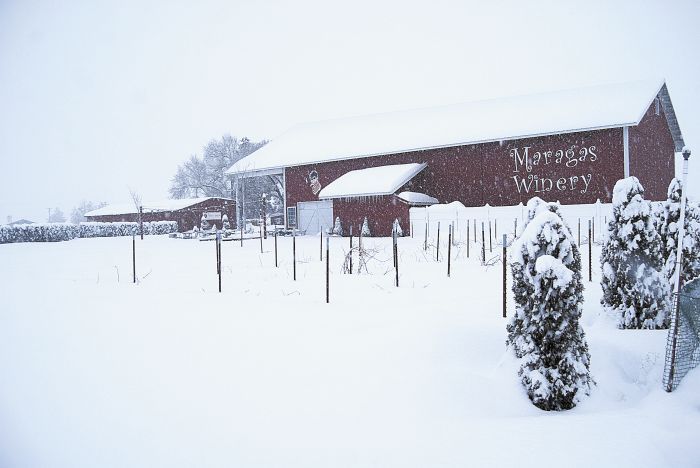Surviving the Cold

By John Gottberg
A severe cold snap in Central Oregon during early December highlighted the difficulties grapegrowers experience in a High Desert climate. Members of the Central Oregon Wine and Grape Growers Association (formerly the Winegrowers Association of Central Oregon) discussed those challenges in a Jan. 29 meeting at the Faith, Hope and Charity Vineyard near Crooked River Ranch.
About 20 vignerons attended the session, chaired by Kerry Damon of the Ranch at the Canyons’ Monkey Face Vineyard near Terrebonne. They reached consensus on two main subjects: First, vines that have been in the ground for several years survive harsh cold far better than those newly planted; second, the future success of Central Oregon grapegrowing might lie in more extensive planting of hybrid varieties.
Deep freeze
Growers acknowledged varying degrees of damage to their crops when the thermometer dropped well below zero for several consecutive nights during the first week of December 2013.
The greatest damage in the region was felt at the Maragas Winery, south of Culver. “We put in 19 acres this year,” said owner Doug Maragas. He doesn’t expect to save more than an acre or two of the new vines.
“The temperature was –19°F one night, –21°F the next,” Maragas said. “Something like this happens twice in 50 years. It’s farming. C’est la vie. I’m glad I’m not a gambler.”
“You plant a vineyard in Central Oregon, you are a gambler,” said Damon.
Maragas said his established vines, planted three and four years ago, survived without a problem. “They have quite a bit of root mass underground and were planted pretty deep,” he explained.
“We have a lot of buds at ground level that were covered by a layer of three to four inches of snow, and those are fine. Twenty-five vinifera varietals, and I think they’re all fine — you can tell by the deep copper or bronze color.”
Maragas said he had already pulled a lot of his young vines. “It’s very likely you’re going to lose above-ground vines for the first couple of years (after you plant them),” he counseled a handful of novice growers.
Damon said the Maragas experience was reflected by other growers in the region. “Everyone inferred that by the third or fourth year, they weren’t seeing this kind of damage,” he said.
“I experienced the same thing — but from the Monkey Face Vineyard standpoint, it’s not yet clear what degree of damage was caused,” Damon said. “Our seven varietals, a fairly small percentage, did show some immediate desiccation on the top of the canes. All that damage will be pruned out in April.
“I took a look at all the blocks and found some cold damage to the canes, the buds, the arms and possibly to the trunks. In some cases I found bud damage, but the canes and trunks were still okay.”
At different stages of the annual growing cycle, said Damon, who once worked for California’s Robert Mondavi Winery, grapes are more or less susceptible to extreme low temperatures. They are most vulnerable, he said, in late fall and early spring, before and after they enter deep winter dormancy. “This year, in early December, we were right on that cusp,” he said.
“Vinifera will tolerate down to about –3°F in the middle of winter,” Damon said. “But it’s still problematic for us when we get temperatures in the 20s in October, and that’s common for us in Central Oregon.
“What can we do as these vines, which are under stress, start to acclimate to winter? Don’t overcrop the vines, don’t withhold nutrients, and keep the vines irrigated! Doing otherwise could leave our Central Oregon vines a little more susceptible to cold temperatures.”
Hybrid hopes
Damon, who in 2006 planted four acres of hybrid grapes, said 2013 produced the best grape harvest in Central Oregon since the industry began in the region. The season provided about 2,000 growing degree-days, significantly more than the average of 1,800 for the region. “It added up to some nice fruit that achieved some nice chemistry degree numbers,” he said.
Monkey Face Vineyard cultivars include La Crescent, St. Croix, Frontenac and Frontenac Gris grapes, all American hybrids, as well as French hybrids Marechal Foch, Vignoles and Leon Millot.
“We’re getting very good results from hybrid grapes,” Damon said. Indications are that they do better in Central Oregon’s hot-summer, cold-winter climate than vinifera, which prefer a more moderate range of temperatures.
In fact, a 2011 La Crescent vintage from Cindy and Robert Grossman’s Faith, Hope & Charity winery won platinum at the 2013 Northwest Food & Wine Festival in Portland in November. The cold-hardy white hybrid was produced with grapes from Monkey Face, whose management the Grossmans have taken over from Damon.
In Faith, Hope & Charity’s own 15-acre vineyard, they are growing Traminette, Marquette and La Crosse hybrids developed in Minnesota and Wisconsin — in addition to the various grapes also at Monkey Face.
“Interspecific hybrids fit very well here,” Damon recently told Mark Ganchiff, publisher of the Chicago-based Midwest Wine Press. “They are early-ripening and most have late bud break.”
Maragas also is experimenting with hybrids. He blends estate-grown Marechal Foch with Pinot Noir, adding body and color to the vinifera grape. And in 2012, his Central Oregon Tootsie, a blend of hybrid La Crescent and Frontenac grapes, won a silver medal at the San Francisco Chronicle Wine Competition.
“Our goal is to combine the best of hybrids and vinifera,” Maragas told Ganchiff. “Quite a few of our customers are interested in trying both.”
John Gottberg Anderson writes about restaurants and travel for The Bulletin, Bend’s daily newspaper. Raised in Eugene, he returned to Oregon several years ago after three decades of chasing grapes around the world.








